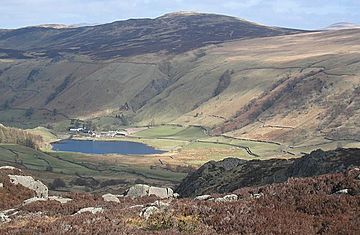High Seat (Lake District) facts for kids
Quick facts for kids High Seat |
|
|---|---|

High Seat above the village of Watendlath. By Ann Bowker.
|
|
| Highest point | |
| Elevation | 608 m (1,995 ft) |
| Prominence | 124 m (407 ft) |
| Parent peak | High Raise |
| Listing | Wainwright |
| Geography | |
| Location | Cumbria, England |
| Parent range | Lake District, Central Fells |
| OS grid | NY287180 |
| Topo map | OS Explorer OL4 |
High Seat is a mountain, or "fell," located right in the middle of England's Lake District. Even though it's not super tall (under 2,000 feet), it's actually the highest point for about five miles around! This is a bit unusual because the very center of the Lake District is lower than the areas around it. High Seat offers amazing views of the beautiful landscape.
Contents
Exploring High Seat's Shape
The main ridge of the Central Fells goes from north to south. High Seat is part of this ridge. To its north is Bleaberry Fell, and to its south, the land dips down towards High Tove.
High Seat has a part that sticks out to the northwest, called Dodd. A stream named Ashness Gill separates Dodd from the main part of the fell. This stream eventually becomes Barrow Beck. The western side of High Seat has many broadleaf trees. Further south, along Watendlath Beck, you'll see more rocks, especially at Reecastle Crag.
The southern edge of High Seat is marked by Raise Gill on the west and Shoulthwaite Gill on the east. These streams are fed by a very wet, boggy area called The Peewits, which is on the ridge leading to High Tove. Shoulthwaite Gill doesn't flow east towards Thirlmere lake as you might expect. Instead, it turns north. It's separated from the lake by lower ridges like Raven Crag and High Rigg. This stream eventually flows into the River Greta. Mere Gill, one of its smaller streams, forms the northeastern edge of High Seat. It starts from a spot on the ridge to Bleaberry Fell called Threefooted Brandreth. A "brandreth" was a three-legged stand used in an oven for baking.
The Litt's Memorial Story
Below Threefooted Brandreth, on the eastern side of High Seat, there is a special memorial. It's called Litt's Memorial. On March 9, 1880, a man named John Litt was following a fox hunt. He fell behind and didn't return home. The next day, a search party found his body in that spot.
The local newspaper, the "English Lakes Visitor and Keswick Guardian," reported on it in March 1880. It said that John Litt and another man, John Vickers, hadn't returned after the hunt. John Litt had last been seen resting and watching the hounds. Even though he seemed tired, he didn't complain. The other hunters were focused on the chase and didn't notice him fall behind. When he didn't come home, many people volunteered to search. They found his body not far from where he was last seen.
The memorial itself has two upright stones. One stone has a round plate that says, "In memory of J Litt who died March 9, 1880." The other stone has an inscription that is now hard to read.
What High Seat is Made Of
The top of High Seat is covered by a soft, spongy material called peat. Underneath the peat, the fell is mostly made of a type of volcanic rock called andesite lava. This rock formed from ancient volcanoes. To the south, there's a small layer of sandstone, which is a rock made from sand grains. The northern slopes are mostly made of a similar volcanic rock, but it contains small crystals called garnet.
Reaching High Seat's Top
The top part of High Seat is quite large, more than a mile wide. It's often soft and boggy, especially along the main ridge. A fence runs along the ridge, which can be helpful if it's foggy. The very top of High Seat has a small rocky area with a marker from the Ordnance Survey, which maps the UK. There's also another rocky bump nearby called Man.
From the summit, you get amazing views! Because High Seat is in the center of the Lake District and doesn't have taller mountains right next to it, you can see far in every direction. You can see the entire Helvellyn range and a wide view of other high fells, from Crinkle Crags in the south to Blencathra in the north.
Ways to Climb High Seat
There are several ways to climb High Seat.
- One way is to park near Ashness Bridge on the road to Watendlath. From there, you can follow Ashness Gill upwards. It gets wetter as you go, but you can eventually head straight for the summit.
- Further up the road, at the base of Reecastle Crag, you can take a more direct path.
- You can also start from the village of Watendlath itself. From there, you would first climb High Tove using zig-zag paths.
- For those starting from the east, you can begin on the A591 road at Rough How Bridge. You would walk along the quiet valley of Shoulthwaite before heading up the fellside near Mere Gill.


